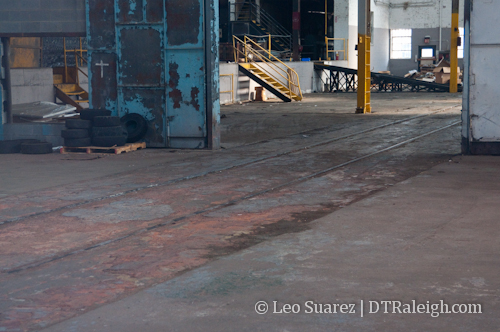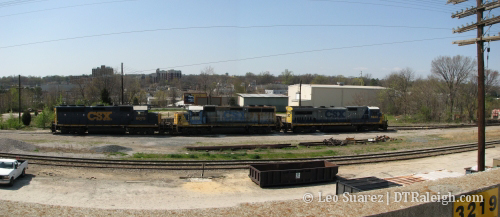View of the Raleigh skyline from inside the Amtrak passenger car as we pulled up on Sunday night. I was with my girlfriend, Jennifer, who writes about the train ride on the Raleigh Public Record.
Tag / Trains
NCDOT Announces Mid-Day Service Between Raleigh and Charlotte, June 5th
From my inbox to yours.
Raleigh— State Transportation Secretary Gene Conti today announced that two additional trains providing mid-day service between Raleigh and Charlotte will begin on Saturday, June 5, increasing the state-sponsored passenger rail service to six trains operating daily between the state’s two largest cities.
“As our population continues to grow, we must provide people with travel alternatives,” said Conti. “Train travel also provides environmental and energy benefits through reduced congestion and improved air quality.”
Currently, the state sponsors four trains daily, the Piedmont and Carolinian, as North Carolina’s Amtrak. Each train makes a morning and evening run between Raleigh and Charlotte, a trip that is auto competitive at 3 hours and 7 minutes, including intermediate stops at Cary, Durham, Burlington, Greensboro, High Point, Salisbury and Kannapolis.
The new service will add two additional trains in the mid-day giving business travelers, families and college students more options to travel via rail. (See attached schedule.)
The Carolinian also provides daily service to Selma, Wilson, Rocky Mount, to Richmond, Virginia and to the northeast including Washington D.C. and New York City.
Federal Rail Administration Deputy Administrator Karen Rae will address the N.C. Board of Transportation at its meeting Wednesday, March 31 regarding the Obama Administration’s policy on transportation choices as a part of building more livable communities and sustainability.
Rae, Conti and Rail Director Patrick Simmons will be available for media interviews regarding the North Carolina’s new mid-day train service between Raleigh and Charlotte; the $545 million in American Recovery and Reinvestment Act funds awarded to the state in February; and the FRA inspection of NCDOT rail equipment, facilities and capabilities from 2:45 p.m.- 3:15 p.m. via telephone by dialing 1-877-531-0014 and then access room# *8569289* and onsite in room 117 in the Transportation Building at 1 S. Wilmington St. To view the live Board of Transportation Web feed, visit http://wms.its.state.nc.us/dotlive.
Buried Tracks In The Warehouse District

High-speed rail and train travel out of downtown sounds like a thing of the future to some people. To others, its a thing of the past now that cars are king and planning of our cities happen around it. It’s no surprise that cities across the country have demolished or abandoned their train stations.
In case you missed it, we’ve mentioned before that Raleigh actually still has its Union Depot, now re-purposed as an office building. It will probably never see trains again but the warehouse district around it continues to have trains roll by. Its possible to uncover some of the older tracks that once ran through here. Let’s jump straight to the maps.

Above is a map of the area around Nash Square in 1914. Union Depot is marked on here as ‘Depot’ and you can see the old tracks leading up to the back of the building coming from the west.

This is a current map overlaid on top of the previous and it is obvious to see that the tracks are not there anymore. You can use a more interactive old/new map overlay at the North Carolina Maps site where I got them from. They set up a very slick Google Map to show this.
The truth is that the tracks were never torn up and are blatantly noticeable if you walk around the warehouse district. The tracks that used to lead up to Union Depot can be seen on West Street, they continue through one of the Dillon warehouses, and there are suspicious cracks along the asphalt leading up to the office buildings behind the old depot.
Click on the pictures for a larger view.

Tracks crossing West Street.

Tracks running through the Dillon Warehouse.

Harrington Street. Look for the cracks in the asphalt in neatly spaced, parallel lines.

The tracks lead up to the offices and disappear underneath.
Next time you are walking in the area, look for the tracks and imagine that at one time passenger trains were unloading people right into Nash Square and a few blocks from Fayetteville Street.
Raleigh’s Union Depot

I’ve recently been following The Infrastructurist blog [Update: broken link] and one of my favorite blog posts recently has been “Demolished! 11 Beautiful Train Stations That Fell To The Wrecking Ball (And The Crappy Stuff Built In Their Place)”. [Update: broken link] Check it out and look at the gorgeous train stations that cities once had but demolished because train travel use was heavily decreasing.
This led me to do some research to see what has happened to some of Raleigh’s old train stations. I’ll have to give a tip of the hat to the Piedmont and Western Railroad Club for this page listing all the train stations in Raleigh. Fortunately for us, most of them have survived and the website lists Union Depot, at the corner of Dawson and Martin Street, still standing today since 1890. Go to the page for more photos, past and present.
See a picture of Union Depot in 1928 on Flickr (via North Carolina State Archives)
Study Continues On High Speed Rail In Raleigh and NC

Discussion about a high speed rail line from Washington DC, through Raleigh, to Charlotte has been mentioned before and we now have an update in the study process. With regards to Raleigh, David Foster, a project manager on the project, states:
The environmental work is substantially complete between the VA-NC line and Raleigh. The initial railroad horizontal and vertical alignment alternatives also are complete along this section. Roadway designs are essentially complete from the VA-NC line through Franklin County, and are in progress through Wake County. The Franklin/Wake County sections are some of the most complex due to heavy development.
Section 106 consultation with the State Historic Preservation Offices in both Virginia and North Carolina is still required. Efforts to obtain the necessary effects determinations for the individual historic resources in each state will begin as the design work is finalized.
The website for the project has a plethora of information, including the entire planned corridor shown with aerial pictures.
http://www.sehsr.org/
Looking at the downtown section we can see what is planned. Before looking, it is pretty easy to guess that the plans are to use the existing rail corridor that runs along capital BLVD into downtown. This makes most sense because of the planned multimodal transit center to be built in the warehouse district. The project timeline was updated last month with an estimate to have passenger service running some time between 2015 and 2020. This is all “dependent upon funding availability” but the gears are rolling and Raleigh may be a major hub for the east coast high speed rail line in the coming decade.

Pic of the Week

Look at all that room for more tracks. The recent release of the final report from the Special Transit Advisory Commission (STAC) involves a train running through this corridor.
East Coast High Speed Rail Conference

We’ll stick with the rail discussion carried over from last week but move from local to regional. Tonight at the Fletcher Opera house will be a conference discussing the possibility of a high-speed rail line for the east coast. The N&O highlights the event:
National rail industry and transportation leaders are coming to Raleigh for a daylong conference Monday to discuss prospects for fast passenger and freight train service that has been proposed for the East Coast.
Monday’s conference, titled “High Speed Rail for the East Coast — It’s Time,” runs from 10 a.m. to 5 p.m. at Fletcher Opera Theatre, 2 E. South St., Raleigh. A fee is charged. Registration details are online at www.wtsncevents.org.
……
“Our goal is to continue to build the support that is necessary for implementing high-speed rail as a relief measure for our over-capacity roads and air-quality challenges,” said Julie E. Hunt of the Women’s Transportation Seminar of North Carolina, organizer of the event.
This probably coincides with Virginia and North Carolina’s study of a high speed rail line between Richmond and Raleigh. You can see more about this proposal here. The southeast high speed rail line would be pretty influential. This would create alternative modes of travel to larger cities such as Atlanta, Charlotte, and Washington DC. If this plan is implemented like the website says, it would make Raleigh a hub, with trains flowing north, south, and west.


